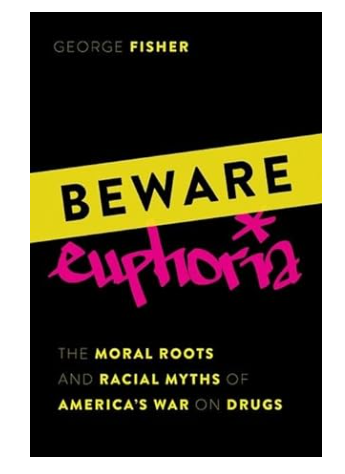SLS’s George Fisher Discusses His New Book About Drugs, Morality, and Race
Stanford Law School’s George Fisher has spent decades exploring the history of criminal law and criminal institutions, including the regulation of alcohol and drugs. His latest book, Beware Euphoria: The Moral Roots and Racial Myths of Today’s War on Drugs, takes a deep historical dive into the surprising link between America’s drug wars and ancient religious strictures against non-procreative sex and drunkenness. Among a host of other issues, Beware Euphoria explores how early drug laws in the United States were passed primarily to shield white people from the snares of moral degradation and addiction. A former Massachusetts assistant attorney general and assistant district attorney, Fisher is the Judge John Crown Professor of law and the faculty co-director of the Criminal Prosecution Clinic at Stanford Law School.

On a recent edition of the Stanford Legal podcast, Fisher sat down with co-host Richard Thompson Ford, the George E. Osborne Professor of Law, to talk about his book, including his take on why our culture broadly accepts alcohol, but rejects other mind-altering substances. The following is an edited excerpt of the full interview, which can be found here. (For more, read the recent Stanford Lawyer article about Beware Euphoria.)
Ford: I know this book has been a real labor of love for you. You’ve worked on the topic for many years. Why did you undertake this project?
I started as a Massachusetts prosecutor and back in the late 1980s and early 1990s, drugs were at the center of everything in the criminal system. There were drug prosecutions themselves, of course, which consumed an awful lot of our energy and a lot of the system’s energy. Then there were all the spinoff crimes—the theft-related crimes that people were addicted to drugs committed to generate the money to pay for those drugs. It was hard to be inside the system and not wonder what the system would be like without all of those drug-related prosecutions, as well as how we got here and why.
Ford: There’s a common narrative today that mass incarceration was largely driven by the war on drugs and that the war on drugs was a result of racism. There’s the famous quote by President Nixon’s aide, John Ehrlichman, who said, we wanted to go after the hippies and Black people, so we tied the hippies to marijuana, we tied the Black people to heroin, and then we went after them. What does your book tell us about that argument?
Mass incarceration is driven by drugs, but not as substantially as people sometimes think. It’s true that in the federal prison system, almost 50 percent of the population are people convicted of drug-related crimes. But the federal system is only about 10 percent of our prison system. In the states, drug-related crimes account for fewer than 20 percent of the people who are imprisoned. Most of the people in prison in the United States today are there for crimes of violence. But the mass incarceration narrative has largely prompted the unwinding of the old drug war. Ever since Michelle Alexander’s book came out in 2010, The New Jim Crow, the focus on mass incarceration and the racially disproportionate ways in which the drug laws are punished, has been enormously influential in breaking down support for the old war on drugs.

The war on drugs is often traced to the Nixon years. That quote you cited from John Ehrlichman was certainly memorable, and no doubt Nixon himself was virulently anti-drug and was probably a racist too, but the drug laws actually took a dip in severity during the Nixon years. They had been more severe before and they became more severe after. The drug war I study in this book is not the Nixon drug war, not even the Rockefeller-Eisenhower drug war of the ’50s, but the drug war of the late 19th century. The early anti-drug laws were laws about whites. They were enforced against those who sold to whites, and especially to young whites and to white women. The driving force was to protect the moral integrity of respectable whites, especially youth and women. It didn’t matter who the sellers were. The early laws against cocaine were largely directed against white pharmacists. So it’s really only in the 20th century that the drug war began to focus on people of color.
Ford: So to the extent there’s racism involved in the early drug laws, it was that lawmakers didn’t care about the people of color. They cared about whites and the effect that drugs would have on corrupting white people, correct?
Yes, it was the racism of indifference. We see that most clearly in the early laws against opium dens. The first shot in the American war on drugs was fired in 1875 when the San Francisco Board of Supervisors enacted the country’s first ordinance against the opium dens, which was the country’s first law against any mind-altering drug other than alcohol. That law was written in race-neutral terms, but was characterized in the press as being the “San Francisco ordinance against white people in opium dens.” Those were the words that were used, not only in San Francisco, but when other anti-opium den laws were enacted in cities and states across the West. The police very self-consciously did not go after opium dens that were kept by the Chinese for the use of Chinese patrons.
Ford: Why opium, later marijuana, but not alcohol, which is clearly also a powerful mind altering drug?
The moral lineage of the drug war goes back to early Christian notions of the wrongfulness of non-procreative sex. Those notions actually trace back earlier, but they were expressed in a very vivid and memorable way by the early Christian fathers who argued, with regard to non-procreative sex, that the sin of such sex was in the way it robs us of our reason—the faculty that most links humans with God. Our heads are up high, closest to the heavens, and we try to erect reason as the emperor over the temptations of the lower parts of our body, certainly our sexual organs, but also our stomachs and the appetitive parts of our character.
The notion was that sex was prototypically an instance in which the mind capitulates to the appetites of the lower members. That notion was expressed in almost unaltered form a millennium and a half later when Puritan theorists began to argue about the wrongfulness of drunkenness. From there, it’s a very short step to imagining the moral denunciation of pleasure-inducing drugs. I know it sounds simplistic, but the striking thing is how thick the evidence is that these threads carry forth from the early Christian times in a more or less unbroken fashion to the late 19th century when drugs first began to be banned.
Alcohol is generally approved only when used in a non-intoxicating way. Imagine the same drug we know today as alcohol—but imagine that the only form of administration of that drug is a single swallow that carries the same punch as 10 shots of vodka, so one could not drink without getting drunk. Would that drug have been legal all these years? I think the answer to that is pretty clearly no. Alcohol is perceived as a drug that can be used in a non-intoxicating way, and it is seen as serving a lot of good, among them easing reasoned intellectual conversation, which is reason-enhancing, not reason-depriving.
Ford: I’m wondering what you make of what’s happening with marijuana today. We’re slowly, it seems, moving in the direction of complete legalization?
The first state that banned cannabis was Massachusetts and four of the first 10 were in New England. It was once again, a story about morality and the protection of youth. But with all of those early state laws, I think with one exception, when they banned cannabis in the early part of the 20th century, they all preserved medical use as lawful. Doctors could continue to prescribe cannabis for a very narrow class of ailments. The striking departure, and the one part of the drug war that does trace particularly to the Nixon era, was the 1970 Controlled Substances Act, which classified cannabis as a Schedule I drug with no recognized medical use. That part was out of line with the whole history of drug and alcohol prohibition, where medical uses have been preserved in both the drug and alcohol realms—and not just cannabis, but also cocaine and the opiates.
So when states began to legalize medical cannabis use, that simply returned us to the old historical status quo. But it was revolutionary when Colorado and Washington and other West Coast states began to legalize recreational cannabis use. The interesting part of that story is what triggered it: We go back again to Michelle Alexander’s book, The New Jim Crow, and the way it brought to a wide audience conversations that had existed largely in the academic world about how the drug war was being weaponized against communities of color. That argument has the catalyst for legalization. The majority of jurisdictions that have legalized cannabis use for recreational purposes have also enacted equity provisions so that the licensing of cannabis dispensaries has been directed predominantly toward those communities hardest hit by the war on drugs, meaning those communities where there has been a higher proportion than elsewhere of cannabis-related arrests. Licenses for cannabis dispensaries have been allocated disproportionately to people who were prosecuted and convicted and imprisoned for cannabis-related crimes during the earlier drug war.
Ford: Now that cannabis use is effectively legal in many states, one of the consequences is that the potency of marijuana being sold, whether on the streets or in the legal dispensaries, has gotten much greater, correct?
I predict that unless those marketing cannabis become savvier about the way they market it, including in terms of the potency, there will be a backlash. That’s exactly the message that will trigger the old moral notions, which are no longer springing from religious authority, but rather from the notions of mind clarity, and the problems with checking out and escaping from reality. We see that in Oregon, where the legislature just this week voted to undo the decriminalization provisions that had been enacted only a couple years ago, during a time when people thought that the war on drugs was truly coming to an end. I think the war on drugs in every realm except for cannabis is still vigorous. And in the realm of cannabis, I would not be shocked if the liberalization trend we’ve been watching stalls at the point where we are now.
Listen to the Stanford Legal Podcast
A former Massachusetts assistant attorney general and assistant district attorney, George Fisher is one of the nation’s top scholars of criminal law and evidence. In his scholarship he explores, through meticulous archival research, the history of criminal law and criminal institutions from prisons to juries, from plea bargaining to the regulation of alcohol and drugs. His publications include an acclaimed casebook on evidence and a history of plea bargaining in America. Professor Fisher is the faculty co-director of the Criminal Prosecution Clinic at the law school and a four-time winner of the John Bingham Hurlbut Award for Excellence in Teaching at Stanford Law School. Before joining the Stanford Law School faculty in 1995, he was a clinical professor at Boston College Law School, an assistant attorney general in the Civil Rights Division of the Massachusetts Attorney General’s Office, and an assistant district attorney for Middlesex County, Massachusetts. Early in his career Professor Fisher clerked for Judge Stephen G. Breyer (BA ’59) of the U.S. Court of Appeals for the First Circuit.
